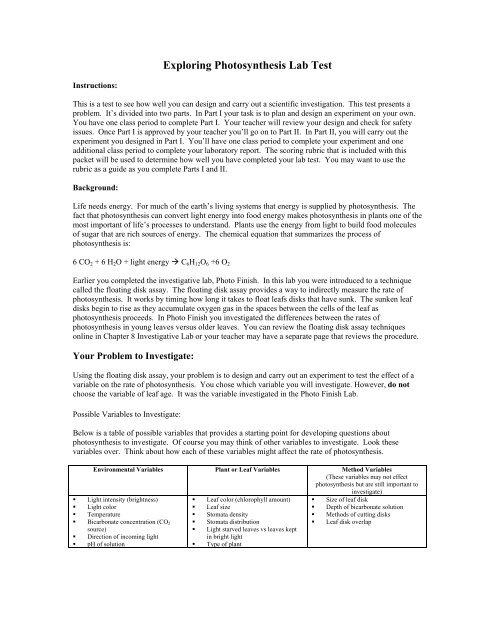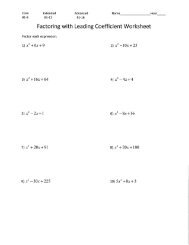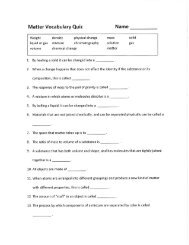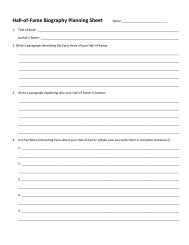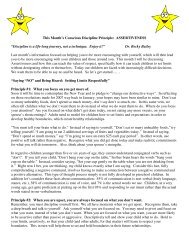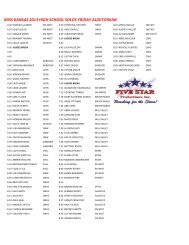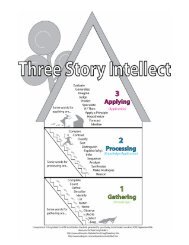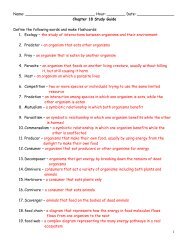Student Designed Lab
Student Designed Lab
Student Designed Lab
Create successful ePaper yourself
Turn your PDF publications into a flip-book with our unique Google optimized e-Paper software.
Exploring Photosynthesis <strong>Lab</strong> TestInstructions:This is a test to see how well you can design and carry out a scientific investigation. This test presents aproblem. It’s divided into two parts. In Part I your task is to plan and design an experiment on your own.You have one class period to complete Part I. Your teacher will review your design and check for safetyissues. Once Part I is approved by your teacher you’ll go on to Part II. In Part II, you will carry out theexperiment you designed in Part I. You’ll have one class period to complete your experiment and oneadditional class period to complete your laboratory report. The scoring rubric that is included with thispacket will be used to determine how well you have completed your lab test. You may want to use therubric as a guide as you complete Parts I and II.Background:Life needs energy. For much of the earth’s living systems that energy is supplied by photosynthesis. Thefact that photosynthesis can convert light energy into food energy makes photosynthesis in plants one of themost important of life’s processes to understand. Plants use the energy from light to build food moleculesof sugar that are rich sources of energy. The chemical equation that summarizes the process ofphotosynthesis is:6 CO 2 + 6 H 2 O + light energy C 6 H 12 O 6 +6 O 2Earlier you completed the investigative lab, Photo Finish. In this lab you were introduced to a techniquecalled the floating disk assay. The floating disk assay provides a way to indirectly measure the rate ofphotosynthesis. It works by timing how long it takes to float leafs disks that have sunk. The sunken leafdisks begin to rise as they accumulate oxygen gas in the spaces between the cells of the leaf asphotosynthesis proceeds. In Photo Finish you investigated the differences between the rates ofphotosynthesis in young leaves versus older leaves. You can review the floating disk assay techniquesonline in Chapter 8 Investigative <strong>Lab</strong> or your teacher may have a separate page that reviews the procedure.Your Problem to Investigate:Using the floating disk assay, your problem is to design and carry out an experiment to test the effect of avariable on the rate of photosynthesis. You chose which variable you will investigate. However, do notchoose the variable of leaf age. It was the variable investigated in the Photo Finish <strong>Lab</strong>.Possible Variables to Investigate:Below is a table of possible variables that provides a starting point for developing questions aboutphotosynthesis to investigate. Of course you may think of other variables to investigate. Look thesevariables over. Think about how each of these variables might affect the rate of photosynthesis.Environmental Variables Plant or Leaf Variables Method Variables(These variables may not effectphotosynthesis but are still important toinvestigate)• Light intensity (brightness)• Light color• Temperature• Bicarbonate concentration (CO 2source)• Direction of incoming light• pH of solution• Leaf color (chlorophyll amount)• Leaf size• Stomata density• Stomata distribution• Light starved leaves vs leaves keptin bright light• Type of plant• Size of leaf disk• Depth of bicarbonate solution• Methods of cutting disks• Leaf disk overlap
Questions:Asking good questions is an important skill. It’s important to ask the right question in the right way. Agood question for scientific inquiry is asked in a way that actually suggests how the question can beanswered. A good question should be focused on how one variable affects another. The resources that areavailable will also limit your question. Also, for this lab test, remember that you only have one day to dothe actual lab work. Make sure your question is answerable in one hour of work.Hypothesis:Your research question can now aid you in developing a good hypothesis to guide your research orexperimental design. A good, working hypothesis helps the investigator limit his or her investigation to theeffect of one variable at a time. This allows the results to be clearly interpreted. To develop a workinghypothesis, you need to establish the variables that you are studying and make a prediction on how thosevariables interact. Forming a hypothesis is a two-step process.1. Define your variables. Determine which variable will change as you manipulate another. Considerthe following question. "Does the temperature of germinating seeds affect the rate of cellularrespiration?" The temperature of the germinating seeds is the manipulated variable (independentvariable) and the rate of respiration is the experimental, or changing, variable (dependentvariable).2. State the relationship between the two variables in an "If... then" format. If the manipulatedvariable effects the experimental variable in such and such a way, then the experimental variableshould change in such and such a manner when the manipulated variable is changed.Minimal Materials:• Plant leaves• Two syringes• Marker• Bicarbonate/detergent solution in a plastic cup• Single hole punch• Strong light source• Clock or watch• Safety glasses or goggles (as recommended by your instructor)
Part I:Your Problem to Investigate:Using the floating disk assay, your problem is to design and carry out an experiment to test the effect of avariable on the rate of photosynthesis. You chose which variable you will investigate. However, do notchoose the variable of leaf age. It was the variable investigated in the Photo Finish <strong>Lab</strong>.a) What is the question you will be investigating?b) Describe the variable you are investigating.c) State your hypothesis.d) Generate a materials list that includes the special items you would need for yourinvestigation.e) Describe the procedure you will use to investigate your hypothesis. Use therubric as a guide for what to include. List the steps you will use. Describe thetype of data that you will collect. You may want include diagrams or illustrations.Be sure to include any safety procedures you will need to follow.f) Construct a data table that you will use to record your observations. Be sure tocorrectly label this table and include any important instructions.Submit your lab test to your teacher after you complete Part I. Do not proceed to Part IIuntil you have your teacher’s approval.Part II:With your teacher’s approval carry out the investigation that you have proposed in part I.You may find that you will need to modify your original procedure and data table as youbegin to investigate your hypothesis. After completing your lab work complete the PartII worksheet as a lab report. Again, use the scoring rubric as a guide for what is expectedin each section of the report.
Photosynthesis <strong>Lab</strong> Test, Part IYour Name:Question:Identification of Variables:Hypothesis:Materials:Procedure:Data Collection & Presentation:
Photosynthesis <strong>Lab</strong> Test, Part IIYour Name:Question:Identification of Variables:Hypothesis:Materials:Procedure:Data Collection & Presentation:Conclusion:


